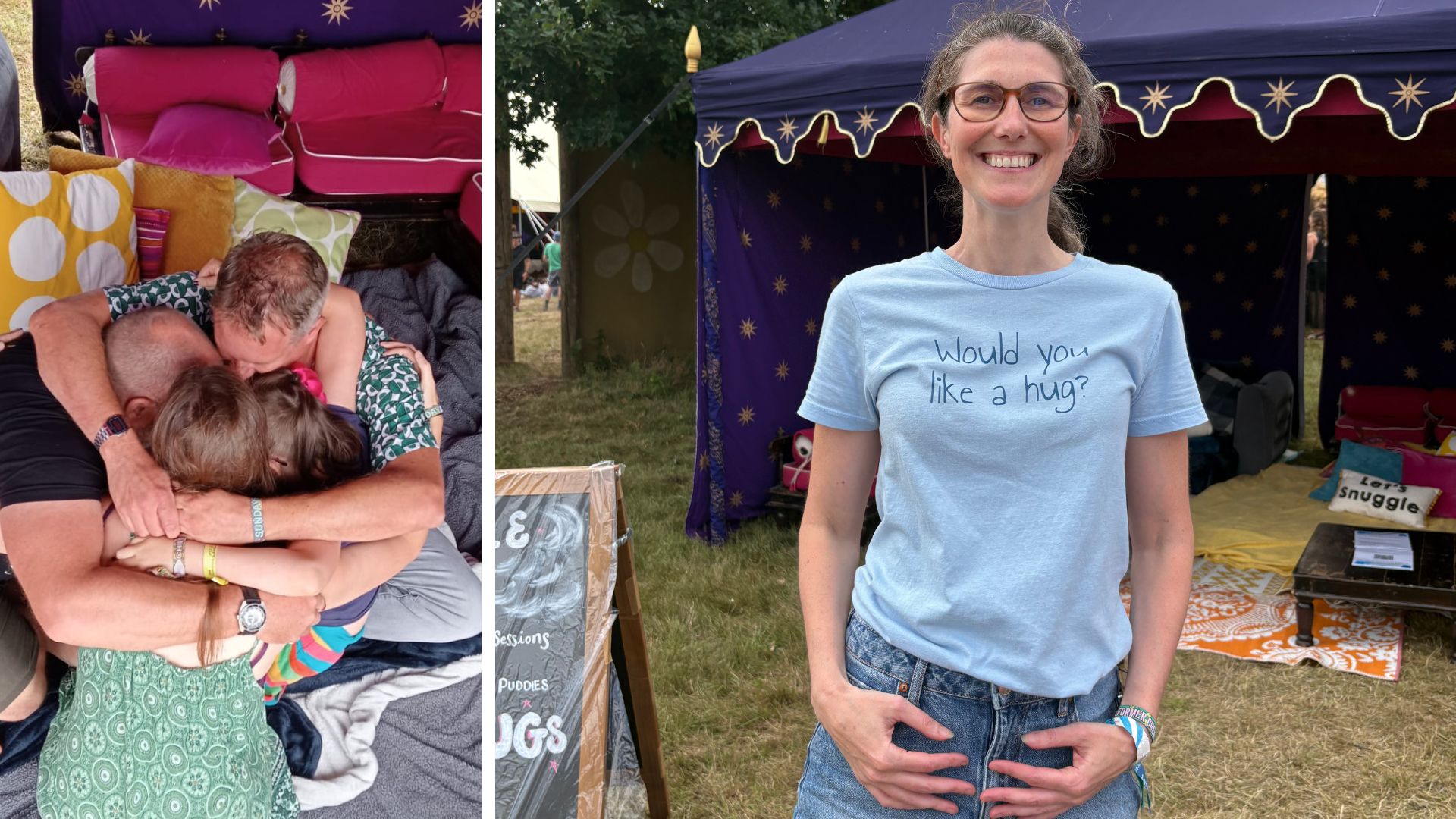“I think we’re in a touch crisis at the moment,” says Samii Wood, 41, who lives on a boat in Bedford, UK.
“Everyone is so disconnected physically from each other, relying on phones, living away from relatives, and sometimes working from home. Many people are lonely and chronically touch-deprived, so it’s no surprise to me that people are interested in cuddle therapy to deal with feelings of isolation. Hugs just feel so good.”
A professional cuddle therapist by trade, Samii is currently launching a ‘hugging movement’ to encourage people to connect more physically, offering individual and group services. Here, she explains the power of cuddle therapy and the secret to a good hug.
The power of touch
“I’m a very tactile person and worked in elderly care and as a Reiki master before I became a cuddle therapist, so I’ve always been conscious of the importance of touch to us as humans – be that holding an elderly patient’s hand or channelling energy in a Reiki session.
“I first heard of cuddle therapy in a US documentary I watched a few years ago, so I was delighted when I attended a women’s retreat called Goddess Conscious Camp, which offered ‘Cuddle Puddles’ (group hugging sessions).
“I found the experience of giving and receiving cuddles profoundly emotional and healing, and I knew I wanted to start to offer cuddle puddles as one of my services.”
Cuddle Training
One of Samii’s cuddle puddle sessions
(Image credit: Samii Wood)
“While it may sound a bit wacky to many, especially stereotypically uptight Brits, cuddle therapy is more normal in the US and expressive Latin American and Mediterranean countries. I discovered an organisation called Cuddle Professionals International, who offer training in becoming a professional cuddler, so I enrolled in their assignment-based programme last year.
“It’s not as simple as learning how to cuddle – I’d like to think I was already pretty good at that! Over a few months, I learnt so much about the science of touch, the benefits of cuddling and of cuddle therapy, got guidance around how to ensure my services were ethically appropriate, and how to have safety and consent be at the forefront of my work.
“I started working as a Cuddle Therapist in January 2025, and it’s been wonderful to see the impact. I see clients in a yoga studio’s therapy room and conduct both 1:1 sessions and group Cuddle Puddles every couple of weeks, while also still offering my Reiki services.
“The response has been great, with some clients travelling long distances to visit me and many saying the cuddle therapy has hugely reduced their stress levels and anxiety, as well as helping in overcoming feelings of loneliness.”
Consent and safety
“The group ‘Cuddle Puddles’ are usually three-hour workshops where we gradually build up understanding around touch through exercises and discuss our own needs before we get to hugging and then spend the last hour connecting in the cuddle puddle itself. It sounds like a long time, but clients often give feedback that they wish it lasted longer.
“I’m very careful to screen 1:1 clients and cuddle puddle attendees before a session to ensure they are coming to me for the right reasons. Having got them to sign a consent form, I know they are clear on the service I offer, and I also do a video call for 1:1 clients to get a sense of their personalities.
“All my therapy is purely platonic and nurturing, which means clients’ partners have no concerns. In many ways, it’s like offering massage therapy – except my clients always have their clothes on!
“It does raise a few eyebrows when people hear what I do. My family is used to me being a bit alternative, but they were still somewhat perplexed when they heard me interviewed on BBC Radio about my new venture. It also took some explaining to my 82-year-old nan, who said it was far too complex to explain to her friends!”
Would you like a hug?

(Image credit: Samii Wood)
“To raise awareness of my services, I created a Hug100 project back in April. Wearing my “Would you like a hug?” t-shirt, I offered strangers on the street 20-second hugs (20 seconds is the key time needed for a hug truly to start to unlock the healing benefits of touch).
“In the end, I hugged 140 people and I’ve just been to Latitude Festival, where I hugged 1,308 people during the long weekend. While there, I also launched the next phase of Hug100 – a huge cuddle day on 27 September, where I’m hoping to get 100 people to commit to hugging another 100 people on the same day.
“If successful, it means that 10,000 hugs would have been given out by the end of the day.”
“It’s wonderful to see the impact that a hug can have. For people who may have been through traumatic experiences in the past, just communicating what they need and want when it comes to touch is a huge breakthrough.
“Some find it very emotional and there are often tears. Holding the space for clients like this can be tiring, so I need to be in the right head space before a session and try to take time alone afterwards to regroup.”
All about intent
“People say I’m a good cuddler (which I guess is essential!) but I think the secret to a good hug is simply in the intention. Our bodies respond differently when hugs are meant and wanted vs those that are begrudgingly given.
“I always meet people with love and respect and, when I hold them in a cuddle, I’m full of positivity and good intentions, which I think people feel when they work with me. I’m so excited at what the future of cuddle therapy might be.
“It’s just wonderful to see people flourish and grow through the power of human touch.”




















